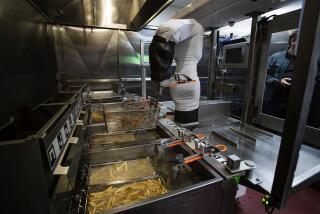Firms Post Biggest Rise in Productivity in 9 Years : Economy: Revised U.S. second-quarter data showing 4.8% increase also says workers didn’t get significantly more pay.
- Share via
American employers, boosting their efficiency with layoffs, hiring freezes and new technology, this spring posted their biggest gain in productivity in nine years.
But figures released Thursday by the U.S. Labor Department also show that the improved business performance failed to translate into significant pay increases for American workers, continuing a two-decade trend of stagnant wages.
The newly revised government statistics show the productivity of non-farm U.S. workplaces climbing 4.8% during the second quarter of this year. That is up from a previously reported 3% for the three-month period and the biggest increase since productivity soared 7% in the first quarter of 1986.
At the same time, unit labor costs--a broad gauge of employers’ payroll expenses--declined 1.2%, the biggest drop since a 2.5% decline in the last quarter of 1993. One key component in those costs, workers’ hourly compensation, edged up a slim 0.1% when adjusted for inflation. Many employers also realized labor cost savings by chopping away at their staffs, in some cases apparently relying more on computer technology to get work done.
To some economists, the latest figures reflect the impressive durability of a continuing national recovery that began in 1991. “After four years, we’re still seeing productivity gains, and there’s no inflation--that’s marvelous,” said Audrey Freedman, a New York labor economist.
The sharply improved productivity figures, coming at a time when the economy is growing modestly overall, demonstrate that “firms were able to squeeze more out of less. It bespeaks tons about the state of American business,” said Robert A. Brusca, chief economist at Nikko Securities in New York.
Still, referring to the widespread staffing cuts, Brusca warned that “we have to wonder if this is a good long-term strategy. It says something about the way labor is being used and abused.”
Hours worked at non-farm businesses declined 2.3%, according to the report, a sign that some laid off full-time workers may be settling for part-time jobs.
Such strategies could, together with the tight lid on wages, eventually backfire on employers by undermining employee morale and loyalty, some analysts argued.
Bill Cunningham, an economist with the AFL-CIO in Washington, said that “workers are not getting their share. These productivity increases have made companies very competitive, and boosted profits enormously. So there’s a lot of room for sharing.”
Productivity is a measure of business efficiency reflecting the per-hour output of all employees. It is widely considered an important economic barometer over the long term because, among other things, it helps determine the competitiveness of a nation’s products in foreign markets, and also its overall standard of living. In fact, a recent international study by two Swiss-based groups rated the U.S. economy as the world’s most competitive for a second consecutive year.
Some economists said Thursday that the latest U.S. productivity figures suggest a brighter economic future for investors and workers alike.
For their part, companies such as Rykoff-Sexton Inc., a Chicago-based manufacturer and distributor of foods and related products, are trying to raise productivity and cut labor costs by introducing new technology. When the company moved its Southern California distribution center from a 1930s-vintage Downtown Los Angeles building to a modern420,000-square-foot building in La Mirada, it also updated many of its management systems with computers.
Now, drivers in the company’s 150 trucks carry on-board computers to monitor everything from fuel consumption to delivery schedules. Forklifts in the plant read bar codes and help keep track of every pallet and carton.
A separate system devises the most efficient geographical grouping of delivery routes in Southern California to reach the firm’s 1,900 customers every day.
The new systems have been in place only three months, but La Mirada operations director Gregory K. Hauter says they eventually could double the number of goods moved.
Even with that increase, the new systems will also result in some staff reductions, though Hauter was reluctant to say just how many.
Meanwhile, major companies ranging from MCI Communications Corp. to MGM Grand Inc. to Times Mirror Co., parent company of the Los Angeles Times, have laid off workers in the last few months in an effort to cut labor costs and improve productivity. Other employers, although they have not cut their staffs, have been slow to hire.
All told, during the second quarter of this year, the nation’s employers added 245,000 workers to their payrolls, less than one-third of the 856,000 added during the same period in 1994.
Some relief may be arriving for job hunters, however: The job market bounced back last month and, in a separate report released Thursday, the ranks of Americans filing first-time claims for unemployment benefits shrank last week, for the first time in a month, by 10,000 to a seasonally adjusted 339,000.
(BEGIN TEXT OF INFOBOX / INFOGRAPHIC)
Big Gains
Non-farm business productivity, percent change from previous quarter at annual rate, seasonally adjusted:
2nd quarter 1995: 4.8%
Source: Labor Department
More to Read
Inside the business of entertainment
The Wide Shot brings you news, analysis and insights on everything from streaming wars to production — and what it all means for the future.
You may occasionally receive promotional content from the Los Angeles Times.










